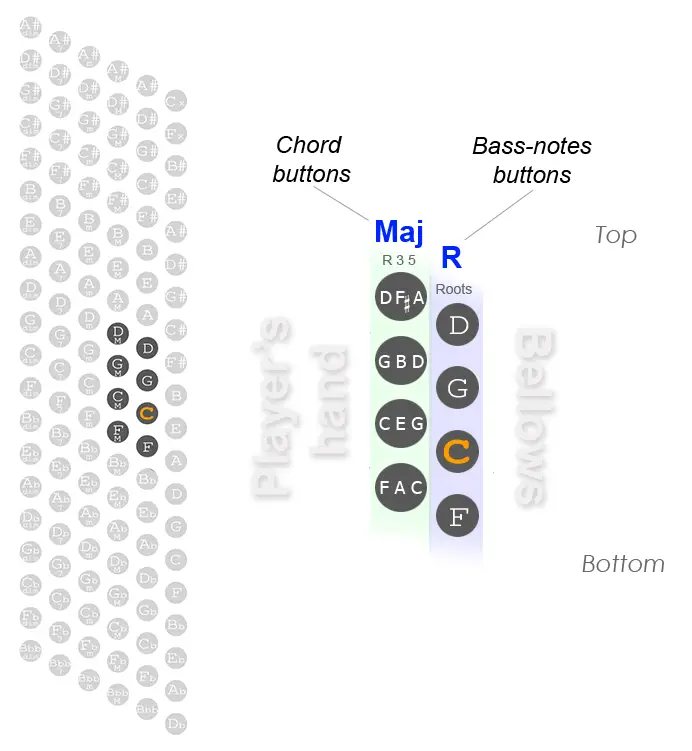The 8 bass is the smallest Stradella bass accordion. It has 1 column of single bass notes (roots), 1 column of chord buttons (Major), and 4 rows.
It is designed to be used by children and makes it easy for beginners to move the first steps on the accordion. However, the repertoire associated with this kind of accordion is very small due to the lack of root notes on the left side.
Stay away from plastic toys: be careful not to buy an accordion toy thinking you can use it to learn to play, they are completely unsuitable as instruments.
An 8 bass accordion can play just 4 roots (F, C, G, D) so 8 keys are missing: (F#/Gb), B, E, A, (Bb/A#), (Eb/D#), (Ab/G#), (Db/C#).
If you are totally new to the Stradella bass system, read this article.
8 Bass Accordion Layout

All chords you can play on an 8 Bass Accordion
The number of chords you can play on an 8 bass accordion is quite low. Actually, there are only 4 major chords in the keys of D, G, C, and F, however, combining chords and roots you can get:
- 1 minor 7th chord
- 2 Dominant 11th chords
- 2 Dominant 9th sus4 chords
- 3 Major 7th/9th chords
Standard Chords
4 Major chords
Major chords are built with a Root (R), a major third (3rd), and a perfect fifth (5th).
On an 8 bass accordion you can play these Major chords:
Combined Chords
1 minor 7th chord
A minor 7th chord is a minor chord with a minor 7th added.
It is built with a Root (R), a minor third (m3rd), a perfect fifth (5th), and a minor seventh (m7th).
On the Stradella bass system, you can play a minor 7th chord by combining a Root with the Major chord built on its minor 3rd interval, for example, C + EbMaj = Cm7.
On an 8 bass accordion you can play just one minor 7th chord:
2 Dominant 11th chords
The Dominant 11th chord is a dominant 7th chord with a major 9th (same as a 2nd) and an 11th (same as a 4th) added.
It is built with a Root (R), a major third (3rd), a perfect fifth (5th), a minor 7th (m7th), a major ninth (9th), and an eleventh (11th).
On the accordion, you can play a Dominant 11th chord by combining a Root and its major chord with the major chord built on its minor 7th interval, for example, C + CMaj + BbMaj = C11.
The 11th interval is dissonant in major and dominant chords because the 11th and the major 3rd are adjacent tones.
For example, C11 = C, E, G, Bb, D, F.
On an 8 bass accordion you can play these Dominant 11th chords:
2 Dominant 9th sus4 chords
Dominant seventh ninth suspended chords (9sus4) consist of a Root (R), no third, a perfect fourth (4th), no fifth, a minor seventh (m7th), and a ninth (9th) note of the major scale built on the root.
Stradella bass system allows you to play 9sus4 chords on the accordion combining the root bass with the major chord of its minor 7th degree, for example, C + BbMaj = C9sus4
On a 8 bass accordion you can play these Dominant 9th sus4 chords:
3 Major 7th/9th chords
The Major 7th/9th chord (Maj7/9) is a Major 7th chord with a major 9th added.
It is built with a Root (R), a major third (3rd), a perfect fifth (5th), a major seventh (7th), and a major ninth (9th).
On the accordion, you can play a Major 7th/9th chord by combining a Root and its Major chord with the Major chord built on the 5th interval from the Root, for example, C + CMaj + GMaj = CMaj7/9.
On an 8 bass accordion you can play these Major 7th/9th chords: